Post History
General cause of noise/interference The interference can be distant (such as lightning) or much closer (such as cables connecting "other" equipment) but, whatever the source, interference can be re...
#6: Post edited
- # General cause of noise/interference
The noise source can be distant (say lightning) or much closer (other equipment conductors) but, whatever the cause, if you have two wires transmitting a signal, then interference can be regarded as "dosing" the same energy onto both wires (screened or un-screened).- # Non-differential input
- How does the non-differential amplifier cope with with interference: -
- 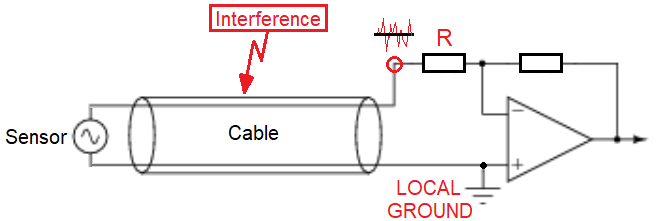
- With a single-ended receiving amplifier, one input is firmly tied to local ground and will be largely unaffected by the interference on the cable. Sure, there'll be an injection of energy but, that energy will be "soaked-up" by the local ground producing very little surge artefacts.
- However, the other input has an impedance to local ground governed by the input resistor, \$R\$ and, it will develop a surge voltage that will be amplified by the single-ended amplifier.
- # Differential input
- This problem can be cancelled by using a differential amplifier: -
- 
- Because both inputs into the differential receiving amplifier have the same impedance to local ground, the interference waveform is seen equally at both input nodes and, the effect of the differential amplifier is to cancel those signals out.
- The other two resistors need to have the same values but they do not need to be the same values as the input resistors. This keeps the amplifier mathematically "differential".
- # Battery-powered receiving amplifier
- You might consider that a battery powered receiver might not need a differential amplifier because the interference would affect both inputs of a single-ended amplifier similarly like this: -
- 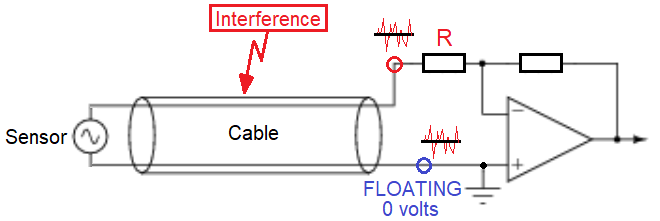
- The above would be OK if the "floating 0 volts" node had the same capacitance to real ground as the node connected to resistor R. This will hardly ever be the case and inevitably, you will still get a differential noise voltage like this: -
- 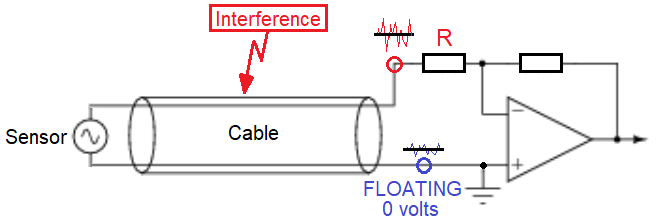
- Using a differential input amplifier is effective because it "presents" a balanced impedance to ground for both wires in the cable.
- # Source/sensor grounded
- The case for a differential amplifier has hopefully been established and, this is also true when the sensor is grounded but now, the output impedance (X) of the sensor has to be factored in: -
- 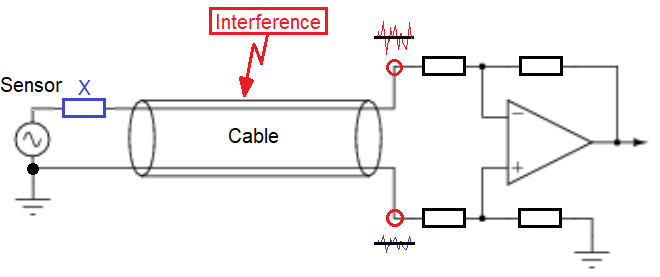
- Because the sensor has a non-zero output impedance (X), cable interference will not be "handled" equally on both wires despite the receiver being differential and balanced. To counter this, you make both wires connected to the sensor terminate with the same impedance (X): -
- 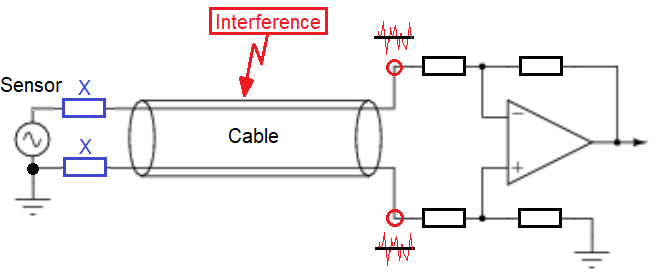
- In the above, both wires will present the same impedance to ground and this is called: -
- $$\boxed{\text{A balanced impedance transmission system}}$$
- And note that a balanced transmission does not require a differential-output sensor; it just needs to be impedance balanced.
- # Cable screen or not?
- The screen causes interference to "dose" both wires more equally but, a bigger advantage is that it acts like a Faraday cage. This results in a lower common-mode interference voltage level and generally means that a differential amplifier will cope better in "harsher" circumstances.
- # Twisted-pair or not?
- Twisting the wire pair is a satisfactory means to ensure that magnetic noise induction (interference) couples equally to both wires and, produces only a common-mode noise voltage signal at the inputs of the differential amplifier.
- # General cause of noise/interference
- The interference can be distant (such as lightning) or much closer (such as cables connecting "other" equipment) but, whatever the source, interference can be regarded as "dosing" the same energy onto both sensor wires (whether screened or un-screened).
- # Non-differential input
- How does the non-differential amplifier cope with with interference: -
- 
- With a single-ended receiving amplifier, one input is firmly tied to local ground and will be largely unaffected by the interference on the cable. Sure, there'll be an injection of energy but, that energy will be "soaked-up" by the local ground producing very little surge artefacts.
- However, the other input has an impedance to local ground governed by the input resistor, \$R\$ and, it will develop a surge voltage that will be amplified by the single-ended amplifier.
- # Differential input
- This problem can be cancelled by using a differential amplifier: -
- 
- Because both inputs into the differential receiving amplifier have the same impedance to local ground, the interference waveform is seen equally at both input nodes and, the effect of the differential amplifier is to cancel those signals out.
- The other two resistors need to have the same values but they do not need to be the same values as the input resistors. This keeps the amplifier mathematically "differential".
- # Battery-powered receiving amplifier
- You might consider that a battery powered receiver might not need a differential amplifier because the interference would affect both inputs of a single-ended amplifier similarly like this: -
- 
- The above would be OK if the "floating 0 volts" node had the same capacitance to real ground as the node connected to resistor R. This will hardly ever be the case and inevitably, you will still get a differential noise voltage like this: -
- 
- Using a differential input amplifier is effective because it "presents" a balanced impedance to ground for both wires in the cable.
- # Source/sensor grounded
- The case for a differential amplifier has hopefully been established and, this is also true when the sensor is grounded but now, the output impedance (X) of the sensor has to be factored in: -
- 
- Because the sensor has a non-zero output impedance (X), cable interference will not be "handled" equally on both wires despite the receiver being differential and balanced. To counter this, you make both wires connected to the sensor terminate with the same impedance (X): -
- 
- In the above, both wires will present the same impedance to ground and this is called: -
- $$\boxed{\text{A balanced impedance transmission system}}$$
- And note that a balanced transmission does not require a differential-output sensor; it just needs to be impedance balanced.
- # Cable screen or not?
- The screen causes interference to "dose" both wires more equally but, a bigger advantage is that it acts like a Faraday cage. This results in a lower common-mode interference voltage level and generally means that a differential amplifier will cope better in "harsher" circumstances.
- # Twisted-pair or not?
- Twisting the wire pair is a satisfactory means to ensure that magnetic noise induction (interference) couples equally to both wires and, produces only a common-mode noise voltage signal at the inputs of the differential amplifier.
#5: Post edited
- # General cause of noise/interference
The source can be distant (say lightning) or much closer like other equipment's conductors but, whatever the cause, if you have two wires transmitting a signal from A to B, then cable interference will put the same "dose" of energy onto both wires (screened or un-screened).- # Non-differential input
- How does the non-differential amplifier cope with with interference: -
- 
With a single-ended receiving amplifier, one input is firmly tied to local ground and will be largely unaffected by the interference on the cable. Sure, there'll be an injection of energy but, that energy will be "soaked-up" by the local ground producing very little surge voltage.- However, the other input has an impedance to local ground governed by the input resistor, \$R\$ and, it will develop a surge voltage that will be amplified by the single-ended amplifier.
- # Differential input
- This problem can be cancelled by using a differential amplifier: -
- 
- Because both inputs into the differential receiving amplifier have the same impedance to local ground, the interference waveform is seen equally at both input nodes and, the effect of the differential amplifier is to cancel those signals out.
The other two resistors need to have the same values but they do not need to be the same as the input resistors.- # Battery-powered receiving amplifier
- You might consider that a battery powered receiver might not need a differential amplifier because the interference would affect both inputs of a single-ended amplifier similarly like this: -
- 
The above would be OK if the "floating 0 volts" node had the same capacitance to real ground as the node connected to resistor R. This will hardly ever be the case and you will still get a differential noise voltage like this: -- 
So, using a differential input amplifier works because it has a balanced impedance to ground.- # Source/sensor grounded
The case for a differential amplifier has hopefully been established and this is also true when the sensor is grounded but now, the output impedance (X) of the sensor has to be factored in: -- 
Because the sensor has a non-zero output impedance (X), cable interference will not be "handled" equally on both wires despite the receiver being differential and balanced. To counter this, you make both wires connecting to the sensor "see" the same impedance: -- 
In the above, both wires will have the same impedance to ground and this is called: -- $$\boxed{\text{A balanced impedance transmission system}}$$
And note that a balanced transmission does not need a differential-output sensor; it just needs to be impedance balanced.- # Cable screen or not?
- The screen causes interference to "dose" both wires more equally but, a bigger advantage is that it acts like a Faraday cage. This results in a lower common-mode interference voltage level and generally means that a differential amplifier will cope better in "harsher" circumstances.
- # General cause of noise/interference
- The noise source can be distant (say lightning) or much closer (other equipment conductors) but, whatever the cause, if you have two wires transmitting a signal, then interference can be regarded as "dosing" the same energy onto both wires (screened or un-screened).
- # Non-differential input
- How does the non-differential amplifier cope with with interference: -
- 
- With a single-ended receiving amplifier, one input is firmly tied to local ground and will be largely unaffected by the interference on the cable. Sure, there'll be an injection of energy but, that energy will be "soaked-up" by the local ground producing very little surge artefacts.
- However, the other input has an impedance to local ground governed by the input resistor, \$R\$ and, it will develop a surge voltage that will be amplified by the single-ended amplifier.
- # Differential input
- This problem can be cancelled by using a differential amplifier: -
- 
- Because both inputs into the differential receiving amplifier have the same impedance to local ground, the interference waveform is seen equally at both input nodes and, the effect of the differential amplifier is to cancel those signals out.
- The other two resistors need to have the same values but they do not need to be the same values as the input resistors. This keeps the amplifier mathematically "differential".
- # Battery-powered receiving amplifier
- You might consider that a battery powered receiver might not need a differential amplifier because the interference would affect both inputs of a single-ended amplifier similarly like this: -
- 
- The above would be OK if the "floating 0 volts" node had the same capacitance to real ground as the node connected to resistor R. This will hardly ever be the case and inevitably, you will still get a differential noise voltage like this: -
- 
- Using a differential input amplifier is effective because it "presents" a balanced impedance to ground for both wires in the cable.
- # Source/sensor grounded
- The case for a differential amplifier has hopefully been established and, this is also true when the sensor is grounded but now, the output impedance (X) of the sensor has to be factored in: -
- 
- Because the sensor has a non-zero output impedance (X), cable interference will not be "handled" equally on both wires despite the receiver being differential and balanced. To counter this, you make both wires connected to the sensor terminate with the same impedance (X): -
- 
- In the above, both wires will present the same impedance to ground and this is called: -
- $$\boxed{\text{A balanced impedance transmission system}}$$
- And note that a balanced transmission does not require a differential-output sensor; it just needs to be impedance balanced.
- # Cable screen or not?
- The screen causes interference to "dose" both wires more equally but, a bigger advantage is that it acts like a Faraday cage. This results in a lower common-mode interference voltage level and generally means that a differential amplifier will cope better in "harsher" circumstances.
- # Twisted-pair or not?
- Twisting the wire pair is a satisfactory means to ensure that magnetic noise induction (interference) couples equally to both wires and, produces only a common-mode noise voltage signal at the inputs of the differential amplifier.
#4: Post edited
- # General cause of noise/interference
The source can be distant (say lightning) or much closer like other equipment's conductors but, whatever the cause, if you have two wires transmitting a signal from A to B, then cable interference will apply the same "dose" of energy to both wires (screened or un-screened).- # Non-differential input
- How does the non-differential amplifier cope with with interference: -
- 
- With a single-ended receiving amplifier, one input is firmly tied to local ground and will be largely unaffected by the interference on the cable. Sure, there'll be an injection of energy but, that energy will be "soaked-up" by the local ground producing very little surge voltage.
- However, the other input has an impedance to local ground governed by the input resistor, \$R\$ and, it will develop a surge voltage that will be amplified by the single-ended amplifier.
- # Differential input
- This problem can be cancelled by using a differential amplifier: -
- 
Because both inputs into the differential receiving amplifier have the same impedance to local ground, the interference waveform is seen equally on both input nodes and, the effect of the differential amplifier is to cancel those signals out.Of course, the other two resistors matter - they also need to have the same values but they do not need to be the same value as the input resistors.- # Battery-powered receiving amplifier
You might consider that a battery powered (or one with a floating isolated power) receiver might not need a differential amplifier because the interference would affect both inputs of a single-ended amplifier like this: -- 
- The above would be OK if the "floating 0 volts" node had the same capacitance to real ground as the node connected to resistor R. This will hardly ever be the case and you will still get a differential noise voltage like this: -
- 
- So, using a differential input amplifier works because it has a balanced impedance to ground.
- # Source/sensor grounded
- The case for a differential amplifier has hopefully been established and this is also true when the sensor is grounded but now, the output impedance (X) of the sensor has to be factored in: -
- 
- Because the sensor has a non-zero output impedance (X), cable interference will not be "handled" equally on both wires despite the receiver being differential and balanced. To counter this, you make both wires connecting to the sensor "see" the same impedance: -
- 
- In the above, both wires will have the same impedance to ground and this is called: -
- $$\boxed{\text{A balanced impedance transmission system}}$$
- And note that a balanced transmission does not need a differential-output sensor; it just needs to be impedance balanced.
- # Cable screen or not?
The screen causes interference to "dose" both wires more equally but, a bigger advantage is that it acts like a Faraday cage. This results in a lower common-mode interference voltage level and generally means that a differential amplifier will cope better.
- # General cause of noise/interference
- The source can be distant (say lightning) or much closer like other equipment's conductors but, whatever the cause, if you have two wires transmitting a signal from A to B, then cable interference will put the same "dose" of energy onto both wires (screened or un-screened).
- # Non-differential input
- How does the non-differential amplifier cope with with interference: -
- 
- With a single-ended receiving amplifier, one input is firmly tied to local ground and will be largely unaffected by the interference on the cable. Sure, there'll be an injection of energy but, that energy will be "soaked-up" by the local ground producing very little surge voltage.
- However, the other input has an impedance to local ground governed by the input resistor, \$R\$ and, it will develop a surge voltage that will be amplified by the single-ended amplifier.
- # Differential input
- This problem can be cancelled by using a differential amplifier: -
- 
- Because both inputs into the differential receiving amplifier have the same impedance to local ground, the interference waveform is seen equally at both input nodes and, the effect of the differential amplifier is to cancel those signals out.
- The other two resistors need to have the same values but they do not need to be the same as the input resistors.
- # Battery-powered receiving amplifier
- You might consider that a battery powered receiver might not need a differential amplifier because the interference would affect both inputs of a single-ended amplifier similarly like this: -
- 
- The above would be OK if the "floating 0 volts" node had the same capacitance to real ground as the node connected to resistor R. This will hardly ever be the case and you will still get a differential noise voltage like this: -
- 
- So, using a differential input amplifier works because it has a balanced impedance to ground.
- # Source/sensor grounded
- The case for a differential amplifier has hopefully been established and this is also true when the sensor is grounded but now, the output impedance (X) of the sensor has to be factored in: -
- 
- Because the sensor has a non-zero output impedance (X), cable interference will not be "handled" equally on both wires despite the receiver being differential and balanced. To counter this, you make both wires connecting to the sensor "see" the same impedance: -
- 
- In the above, both wires will have the same impedance to ground and this is called: -
- $$\boxed{\text{A balanced impedance transmission system}}$$
- And note that a balanced transmission does not need a differential-output sensor; it just needs to be impedance balanced.
- # Cable screen or not?
- The screen causes interference to "dose" both wires more equally but, a bigger advantage is that it acts like a Faraday cage. This results in a lower common-mode interference voltage level and generally means that a differential amplifier will cope better in "harsher" circumstances.
#3: Post edited
- # Non-differential input
Consider the non-differential amplifier scenario with interference being picked up by the cable: -- 
With the receiving amplifier being single ended, one input is firmly tied to local ground and that ground node will be largely unaffected by the interference on the cable. Sure, there'll be an injection of current but that current will be "soaked-up" by the local ground.However, the other input has an impedance to local ground governed by the input resistor, \$R\$ and will develop a voltage that will be simply amplified by the single-ended amplifier.- # Differential input
- This problem can be cancelled by using a differential amplifier: -
- 
- Because both inputs into the differential receiving amplifier have the same impedance to local ground, the interference waveform is seen equally on both input nodes and, the effect of the differential amplifier is to cancel those signals out.
- Of course, the other two resistors matter - they also need to have the same values but they do not need to be the same value as the input resistors.
- # Battery-powered receiving amplifier
You might consider that a battery powered (or one with a floating isolated power) receiver might not need a differential amplifier because the interference would affect both inputs of a single-ended amplifier the same as per this: -- 
- The above would be OK if the "floating 0 volts" node had the same capacitance to real ground as the node connected to resistor R. This will hardly ever be the case and you will still get a differential noise voltage like this: -
- 
Using a differential input amplifier works because it has a balanced impedance to ground.- # Source/sensor grounded
- The case for a differential amplifier has hopefully been established and this is also true when the sensor is grounded but now, the output impedance (X) of the sensor has to be factored in: -
- 
Because the sensor will have a non-zero output impedance (X), interference onto the cable will not be equally distributed to both wires despite the receiver being differential and balanced. To counter this, it is now important to make the impedances of both wires connecting to the sensor have the same impedance: -- 
- In the above, both wires will have the same impedance to ground and this is called: -
- $$\boxed{\text{A balanced impedance transmission system}}$$
And note that a balanced transmission does not need a differential-output sensor; it just needs to be impedance balanced.
- # General cause of noise/interference
- The source can be distant (say lightning) or much closer like other equipment's conductors but, whatever the cause, if you have two wires transmitting a signal from A to B, then cable interference will apply the same "dose" of energy to both wires (screened or un-screened).
- # Non-differential input
- How does the non-differential amplifier cope with with interference: -
- 
- With a single-ended receiving amplifier, one input is firmly tied to local ground and will be largely unaffected by the interference on the cable. Sure, there'll be an injection of energy but, that energy will be "soaked-up" by the local ground producing very little surge voltage.
- However, the other input has an impedance to local ground governed by the input resistor, \$R\$ and, it will develop a surge voltage that will be amplified by the single-ended amplifier.
- # Differential input
- This problem can be cancelled by using a differential amplifier: -
- 
- Because both inputs into the differential receiving amplifier have the same impedance to local ground, the interference waveform is seen equally on both input nodes and, the effect of the differential amplifier is to cancel those signals out.
- Of course, the other two resistors matter - they also need to have the same values but they do not need to be the same value as the input resistors.
- # Battery-powered receiving amplifier
- You might consider that a battery powered (or one with a floating isolated power) receiver might not need a differential amplifier because the interference would affect both inputs of a single-ended amplifier like this: -
- 
- The above would be OK if the "floating 0 volts" node had the same capacitance to real ground as the node connected to resistor R. This will hardly ever be the case and you will still get a differential noise voltage like this: -
- 
- So, using a differential input amplifier works because it has a balanced impedance to ground.
- # Source/sensor grounded
- The case for a differential amplifier has hopefully been established and this is also true when the sensor is grounded but now, the output impedance (X) of the sensor has to be factored in: -
- 
- Because the sensor has a non-zero output impedance (X), cable interference will not be "handled" equally on both wires despite the receiver being differential and balanced. To counter this, you make both wires connecting to the sensor "see" the same impedance: -
- 
- In the above, both wires will have the same impedance to ground and this is called: -
- $$\boxed{\text{A balanced impedance transmission system}}$$
- And note that a balanced transmission does not need a differential-output sensor; it just needs to be impedance balanced.
- # Cable screen or not?
- The screen causes interference to "dose" both wires more equally but, a bigger advantage is that it acts like a Faraday cage. This results in a lower common-mode interference voltage level and generally means that a differential amplifier will cope better.
#2: Post edited
- Consider the non-differential amplifier scenario with interference being picked up by the cable: -
- 
- With the receiving amplifier being single ended, one input is firmly tied to local ground and that ground node will be largely unaffected by the interference on the cable. Sure, there'll be an injection of current but that current will be "soaked-up" by the local ground.
- However, the other input has an impedance to local ground governed by the input resistor, \$R\$ and will develop a voltage that will be simply amplified by the single-ended amplifier.
- This problem can be cancelled by using a differential amplifier: -
- 
- Because both inputs into the differential receiving amplifier have the same impedance to local ground, the interference waveform is seen equally on both input nodes and, the effect of the differential amplifier is to cancel those signals out.
Of course, the other two resistors matter - they also need to have the same values but they do not need to be the same value as the input resistors.
- # Non-differential input
- Consider the non-differential amplifier scenario with interference being picked up by the cable: -
- 
- With the receiving amplifier being single ended, one input is firmly tied to local ground and that ground node will be largely unaffected by the interference on the cable. Sure, there'll be an injection of current but that current will be "soaked-up" by the local ground.
- However, the other input has an impedance to local ground governed by the input resistor, \$R\$ and will develop a voltage that will be simply amplified by the single-ended amplifier.
- # Differential input
- This problem can be cancelled by using a differential amplifier: -
- 
- Because both inputs into the differential receiving amplifier have the same impedance to local ground, the interference waveform is seen equally on both input nodes and, the effect of the differential amplifier is to cancel those signals out.
- Of course, the other two resistors matter - they also need to have the same values but they do not need to be the same value as the input resistors.
- # Battery-powered receiving amplifier
- You might consider that a battery powered (or one with a floating isolated power) receiver might not need a differential amplifier because the interference would affect both inputs of a single-ended amplifier the same as per this: -
- 
- The above would be OK if the "floating 0 volts" node had the same capacitance to real ground as the node connected to resistor R. This will hardly ever be the case and you will still get a differential noise voltage like this: -
- 
- Using a differential input amplifier works because it has a balanced impedance to ground.
- # Source/sensor grounded
- The case for a differential amplifier has hopefully been established and this is also true when the sensor is grounded but now, the output impedance (X) of the sensor has to be factored in: -
- 
- Because the sensor will have a non-zero output impedance (X), interference onto the cable will not be equally distributed to both wires despite the receiver being differential and balanced. To counter this, it is now important to make the impedances of both wires connecting to the sensor have the same impedance: -
- 
- In the above, both wires will have the same impedance to ground and this is called: -
- $$\boxed{\text{A balanced impedance transmission system}}$$
- And note that a balanced transmission does not need a differential-output sensor; it just needs to be impedance balanced.
#1: Initial revision
Consider the non-differential amplifier scenario with interference being picked up by the cable: -  With the receiving amplifier being single ended, one input is firmly tied to local ground and that ground node will be largely unaffected by the interference on the cable. Sure, there'll be an injection of current but that current will be "soaked-up" by the local ground. However, the other input has an impedance to local ground governed by the input resistor, \$R\$ and will develop a voltage that will be simply amplified by the single-ended amplifier. This problem can be cancelled by using a differential amplifier: -  Because both inputs into the differential receiving amplifier have the same impedance to local ground, the interference waveform is seen equally on both input nodes and, the effect of the differential amplifier is to cancel those signals out. Of course, the other two resistors matter - they also need to have the same values but they do not need to be the same value as the input resistors.


















